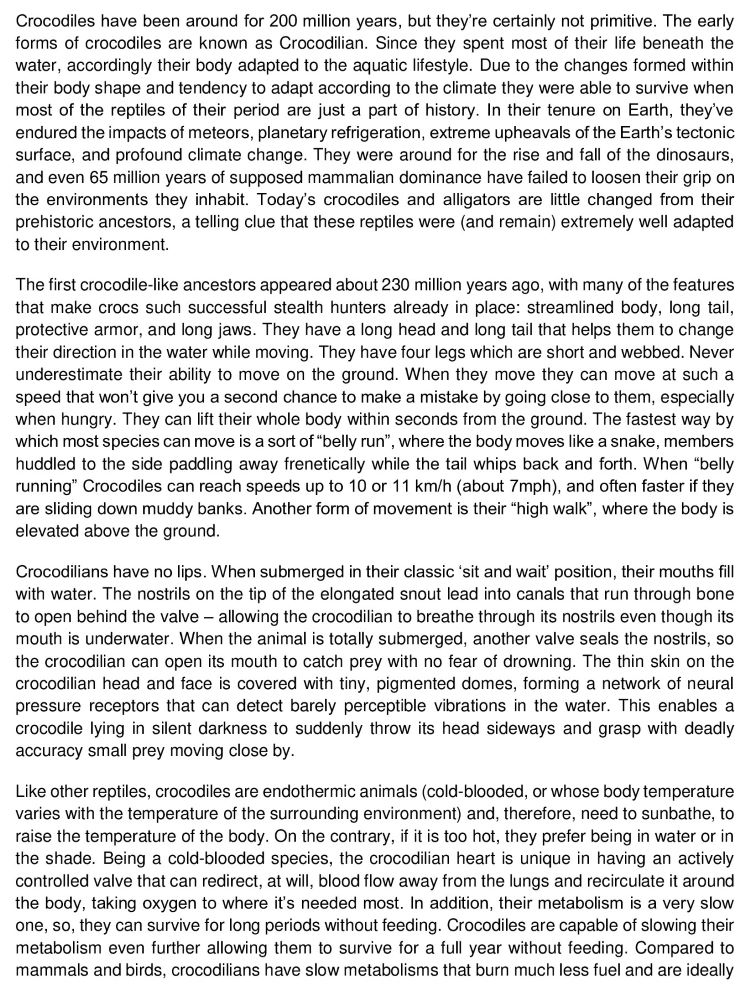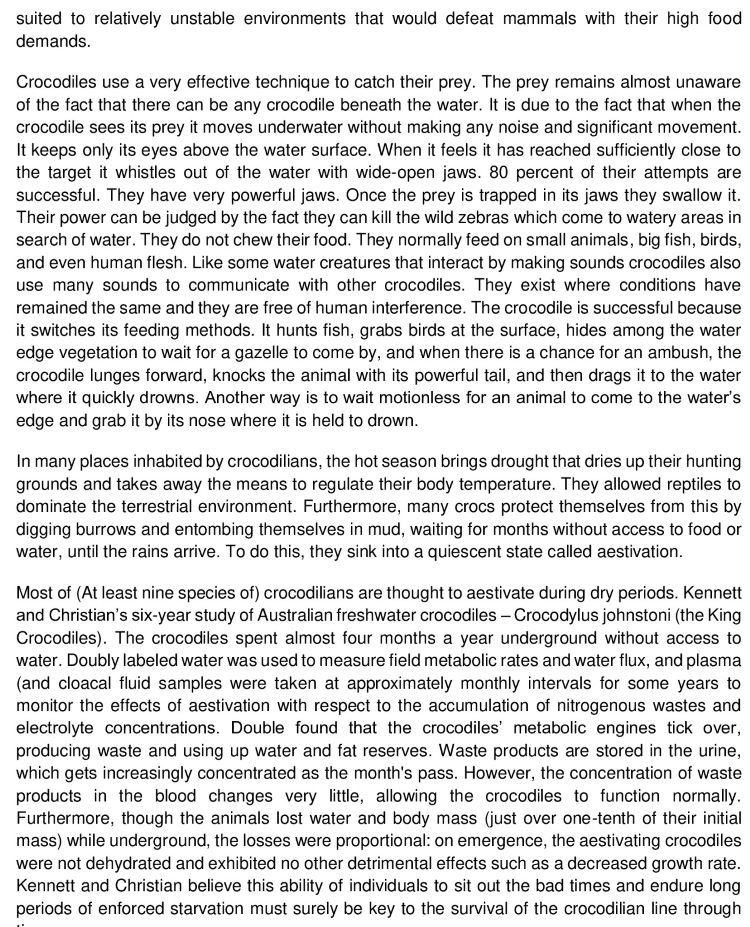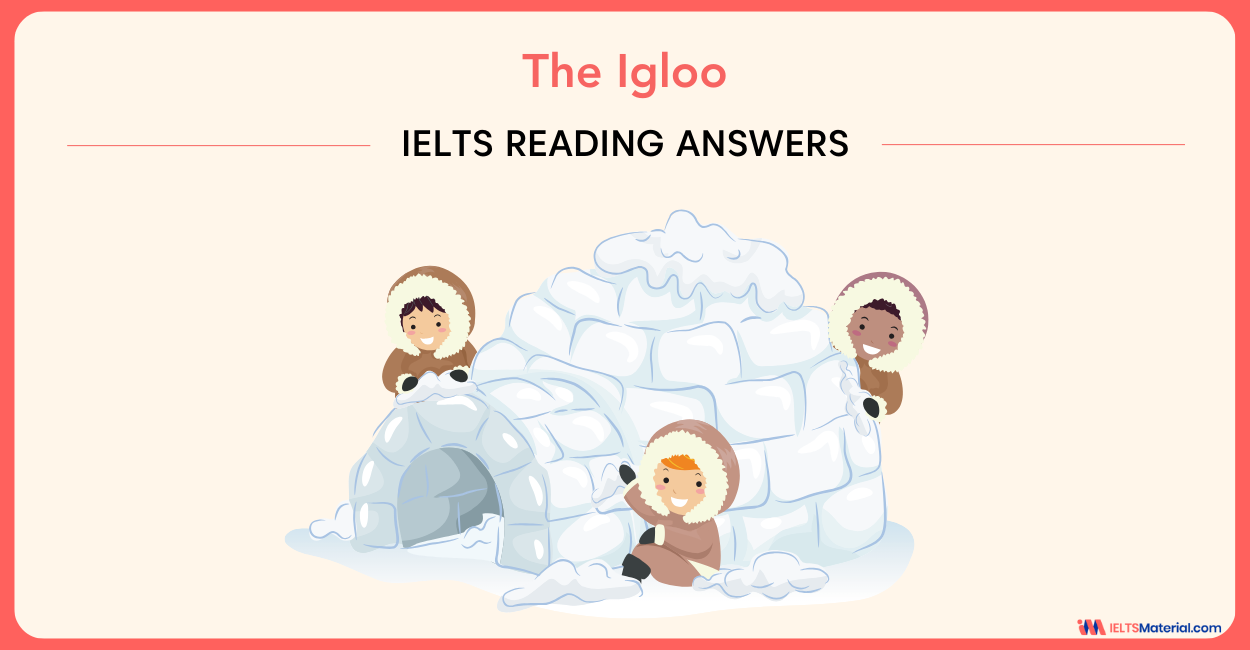The Evolutionary Mystery: Crocodile Survives - IELTS Reading Answer
12 min read
Updated On
-
Copy link
Buckle up to crack the Evolutionary Mystery: Crocodile Survives for a band 9 in your final test. The best is that you get to check your answers at once and complete them within 20 minutes!
Table of Contents
- Reading Passage
- Questions from The Evolutionary Mystery: Crocodile Survives IELTS Reading Passage
- Answers of The Evolutionary Mystery: Crocodile Survives Reading Passage With Location and Explanation
- Tips for Answering the Question Types in The Evolutionary Mystery: Crocodile Survives Reading Answers

Limited-Time Offer : Access a FREE 10-Day IELTS Study Plan!
‘The Evolutionary Mystery: Crocodile Survives’ IELTS Reading passage is a great resource for anyone who is preparing for the IELTS Reading test! Giving this a shot will help you understand the kind of reading passages and question types you will encounter in your final test.
To have an enhanced reading preparation, crack the “The Evolutionary Mystery: Crocodile Survives” IELTS Reading answers now and score a band 8 or above in your actual IELTS exam.
The question types in this IELTS Academic Reading Passage include:
Reading Passage
You should spend about 20 minutes on Questions 14-26, which are based on the Reading Passage below.
The Evolutionary Mystery: Crocodile Survives


Questions from The Evolutionary Mystery: Crocodile Survives IELTS Reading Passage
Questions 14-20
(The evolutional mystery reading answers)
The Reading passage has seven paragraphs, A-G.
Choose the correct heading for paragraphs A-G from the list below.
Write the correct number, i-xi, in boxes 14-20 on your answer sheet.
List of Headings
- The competitors with the dinosaur
- A historical event for the Supreme survivors
- What makes the crocodile the fastest running animal on land
- Regulated body temperature by the surrounding environment
- Underwater aid in body structure offered to a successful predator
- The perfectly designed body for a great land roamer
- Slow metabolisms which make crocodile a unique reptile
- The favorable features in the impact of a drought
- Shifting Eating habits and food intake
- A project on a special mechanism
- A unique finding has been achieved recently
14 Paragraph A
15 Paragraph B
16 Paragraph C
17 Paragraph D
18 Paragraph E
19 Paragraph F
20 Paragraph G
Questions 21-26
In many places inhabited by crocodilians, most types of the crocodile have evolved a successful scheme to survive in the drought brought by a 21……………………… According to Kennett and Christian’s six-year study of Australian freshwater crocodiles’ aestivation, they found Aestivating crocodiles spent around 22……………………… a year without access to 23……………………… The absolute size of body water pools declined proportionately with 24………………………; thus there is no sign of 25……………………… and other health-damaging impacts in the crocodiles even after an aestivation period. This super capacity helps crocodiles endure the tough drought without slowing their speed of 26……………………… significantly.
Book a FREE online class to discuss any doubt related to how to solve different IELTS questions!
Answers of The Evolutionary Mystery: Crocodile Survives Reading Passage With Location and Explanation
Scroll down for the answers to the IELTS Academic passage, The Evolutionary Mystery: Crocodile Survives, and find out the IELTS band score you get for this passage.
14 Answer: ii
Question type: Matching Headings
Answer location: Paragraph A
Answer explanation: Paragraph A the early forms of crocodiles are known as crocodilians. Since they spent most of their life beneath the water, accordingly their body adapted to the aquatic lifestyle. Due to the changes formed within their body shape and tendency to adapt according to the climate they were able to survive when most of the reptiles of their period are just a part of history. In their tenure on Earth, they’ve endured the impacts of meteors, planetary refrigeration, extreme upheavals of the Earth’s tectonic surface, and profound climate change. They were around for the rise and fall of the dinosaurs, and even 65 million years of supposed mammalian dominance have failed to loosen their grip on the environments they inhabit. We understand from these lines that the crocodiles are the supreme survivors of history as they’ve witnessed the impacts of meteors, planetary refrigeration, extreme upheavals, etc. They were also around the rise and extinction of the dinosaurs. Thus, paragraph A illustrates a historical event for the Supreme Survivors. Hence, the answer is A.
15 Answer: vi
Question type: Matching Headings
Answer location: Paragraph B
Answer explanation: Paragraph B explains the body structure of the crocodile. It is stated that the first crocodile-like ancestors appeared about 230 million years ago, with many of the features that make crocs such successful stealth hunters already in place: streamlined body, long tail, protective armor, and long jaws. They have a long head and long tail that helps them to change their direction in the water while moving. They have four legs which are short and webbed. These lines suggest that the crocodiles have the perfectly designed body for great land roaming. Their ability to move on the ground is fascinating. Hence, paragraph B elucidates the perfectly designed and structured body of a great land roamer (crocodile). Thus, the answer is vi.
16 Answer: v
Question type: Matching Headings
Answer location: Paragraph C
Answer explanation: Paragraph C states that crocodilians have no lips. When submerged in their classic ‘sit and wait’ position, their mouths fill with water. The nostrils on the tip of the elongated snout lead into canals that run through bone to open behind the valve – allowing the crocodilian to breathe through its nostrils even though its mouth is underwater. When the animal is totally submerged, another valve seals the nostrils, so the crocodilian can open its mouth to catch prey with no fear of drowning. These lines indicate how crocodiles aid themselves underwater. It is also evident how paragraph C illustrates the underwater aid in body structure offered to a successful predator. Hence, the answer is v.
17 Answer: iv
Question type: Matching Headings
Answer location: Paragraph D
Answer explanation: Paragraph D states that like other reptiles, crocodiles are endothermic animals (cold-blooded, or whose body temperature varies with the temperature of the surrounding environment) and, therefore, need to sunbathe, to raise the temperature of the body. On the contrary, if it is too hot, they prefer being in water or in the shade. Being a cold-blooded species, the crocodilian heart is unique in having an actively controlled valve that can redirect, at will, blood flow away from the lungs and recirculate it around the body, taking oxygen to where it’s needed most. In addition, their metabolism is a very slow one, so, they can survive for long periods without feeding. Therefore, it is evident from these lines that paragraph D explains the regulated temperature of the crocodiles by the surrounding environment. Hence, the answer is iv.
18 Answer: ix
Question type: Matching Headings
Answer location: Paragraph E
Answer explanation: In paragraph E, it is mentioned that Crocodiles use a very effective technique to catch their prey. The prey remains almost unaware of the fact that there can be any crocodile beneath the water. It is due to the fact that when the crocodile sees its prey it moves underwater without making any noise and significant movement. It keeps only its eyes above the water surface. When it feels it has reached sufficiently close to the target it whistles out of the water with wide-open jaws. 80 percent of their attempts are successful. They have very powerful jaws. Once the prey is trapped in its jaws they swallow it. Their power can be judged by the fact they can kill the wild zebras which come to watery areas in search of water. They do not chew their food. Paragraph E elucidates the eating habits of crocodiles in water as well as land. Their shifting eating habits and food intake are also mentioned in the paragraph. Hence, the answer is ix.
19 Answer: viii
Question type: Matching Headings
Answer location: Paragraph F
Answer explanation: Paragraph F states that in many places inhabited by crocodilians, the hot season brings drought that dries up their hunting grounds and takes away the means to regulate their body temperature. They allowed reptiles to dominate the terrestrial environment. Furthermore, many crocs protect themselves from this by digging burrows and entombing themselves in mud, waiting for months without access to food or water, until the rains arrive. To do this, they sink into a quiescent state called aestivation. We can deduce from these lines that paragraph F illustrates the most favorable characteristics of the impact of drought in the areas where crocodiles live. Thus, the answer is viii.
20 Answer: x
Question type: Matching Headings
Answer location: Paragraph G
Answer explanation: Paragraph G state that the crocodiles spent almost four months a year underground without access to water. Doubly labeled water was used to measure field metabolic rates and water flux, and plasma (and cloacal fluid samples were taken at approximately monthly intervals for some years to monitor the effects of aestivation with respect to the accumulation of nitrogenous wastes and electrolyte concentrations. Double found that the crocodiles’ metabolic engines tick over, producing waste and using up water and fat reserves. Waste products are stored in the urine, which gets increasingly concentrated as the month’s pass. However, the concentration of waste products in the blood changes very little, allowing the crocodiles to function normally. We can deduce from paragraph G that according to the 6-year study of Australian freshwater crocodiles by Kennett and Christian, it is understood that the crocodiles spent around four months a year underground without access to water. Therefore, it is clear that paragraph G explains Kennet and Christian’s project on a special mechanism. Hence, the answer is x.
21 Answer: dry season/ hot season/ dry period
Question type: Summary Completion
Answer location: Paragraph F & G
Answer explanation: The introductory lines of paragraph H states that in many places inhabited by crocodilians, the hot season brings drought that dries up their hunting grounds and takes away the means to regulate their body temperature. In paragraph G, it is mentioned that most (At least nine species of) crocodilians are thought to aestivate during dry periods. Kennett and Christian’s six-year study of Australian freshwater crocodiles – Crocodylus johnstoni (the King Crocodiles). These lines indicate that in many places inhabited by crocodiles, most types of crocodiles have evolved a successful scheme to survive in the drought brought by a hot season or dry period. Thus, the answer is hot season/ dry season/ dry period.
22 Answer: four months
Question type: Summary Completion
Answer location: Paragraph G, line 3
Answer explanation: The 3rd line of paragraph G states that the crocodiles spent almost four months a year underground without access to water. We understand from these lines that according to Kennett and Christian’s study of Australian freshwater crocodiles’ aestivation, they found aestivating crocodiles spent around 4 months a year underground without access to water. Hence, the answer is four months.
23 Answer: water
Question type: Summary Completion
Answer location: Paragraph G, line 3
Answer explanation:
The 3rd line of paragraph G states that the crocodiles spent almost four months a year underground without access to water. These lines indicate that according to Kennett and Christian’s study of Australian freshwater crocodiles’ aestivation, they found aestivating crocodiles spent around 4 months a year underground without access to water. Hence, the answer is water.
24 Answer: body mass
Question type: Summary Completion
Answer location: Paragraph G, line 11
Answer explanation: In the eleventh line of paragraph G, it is stated that though the animals lost water and body mass (just over one-tenth of their initial mass) while underground, the losses were proportional: to emergence. These lines indicate that after the crocodiles had spent four months underground without access to food, as a result of which, the absolute size of body water pools declined proportionately with body mass. Hence, the answer is body mass.
25 Answer: dehydration
Question type: Summary Completion
Answer location: Paragraph G, line 11
Answer explanation: The 11th line of paragraph G states that furthermore, though the animals lost water and body mass (just over one-tenth of their initial mass) while underground, the losses were proportional: on emergence, the aestivating crocodile was not dehydrated and exhibited no detrimental effects such as a decreased growth rate. We understand from paragraph G that when the crocodiles are underground without access to food, their absolute size of body water pools declines proportionately with dehydration. Thus, the answer is dehydration.
26 Answer: growth
Question type: Summary Completion
Answer location: Paragraph G, line 11
Answer explanation: The 11th line of paragraph G states that though the animals lost water and body mass (just over one-tenth of their initial mass) while underground, the losses were proportional: on emergence, the aestivating crocodile was not dehydrated and exhibited no detrimental effects such as a decreased growth rate. These lines indicate that the absolute size of body water pools declined proportionately with body mass, thus, there’s no sign of dehydration and other health-damaging impacts in the crocodiles even after an aestivation period. This super capacity helps crocodiles endure the tough drought without slowing their speed of growth significantly. Thus, the answer is growth.
Want to improve your IELTS Academic Reading score? Grab Our IELTS Reading Ebook Today!
Tips for Answering the Question Types in The Evolutionary Mystery: Crocodile Survives Reading Answers
Now let’s get started with the IELTS exam preparation tips for each question type. It’ll help you understand how to approach the problem of each question type.
IELTS Reading Summary Completion
In the summary completion task, you fill in the blanks in a summary of a passage using information from the text. This tests your ability to understand the main ideas and details of the passage.
Tips for Summary Completion
- Read the Summary First: Familiarize yourself with the summary to understand its context and the information it covers.
- Identify Keywords: Look for keywords using the IELTS Reading keyword techniques in the summary blanks that will guide you in finding the relevant parts of the passage.
- Skim the Passage: Quickly read through the passage to get a general understanding, then focus on sections that relate to the summary.
- Use Exact Words: When filling in blanks, use words directly from the passage to ensure accuracy and adherence to any word limits.
- Check for Context: Make sure your answers fit both the meaning and context of the summary, ensuring they accurately reflect the information from the passage.
IELTS Reading Matching Headings
Matching headings in the IELTS Reading section involves connecting headings to the correct sections of the text. Here are five tips to help you with this task:
- Understand the Main Idea: Skim through the headings and the text to get a general idea of what each section is about. Each heading represents the main idea of a paragraph or section, so understanding this will help you match them more effectively.
- Read the First and Last Sentences: Focus on the first and last sentences of each paragraph. They often contain the main idea or summary of the paragraph, which can help you identify the correct heading.
- Look for Keywords: Pay attention to keywords or phrases in the heading and find them or related synonyms in the paragraph. Matching these can guide you to the right heading.
- Ignore the Detail: Don’t get bogged down by details. The heading will usually summarize the overall idea of the paragraph, not the specifics. Focus on the broader theme or concept.
- Eliminate Wrong Options: If you’re unsure, eliminate headings that clearly don’t fit the section. This can narrow down your choices and increase your chances of selecting the correct heading.
Kudos! For solving The Evolutionary Mystery: Crocodile Survives IELTS reading passage! Now to do even better in your IELTS Reading section solve IELTS Reading recent actual tests.
Check More IELTS Reading Answers
Practice IELTS Reading based on question types

Start Preparing for IELTS: Get Your 10-Day Study Plan Today!
Explore other Reading Topics

Kasturika Samanta

Kasturika Samanta

Kasturika Samanta

Kasturika Samanta
Recent Articles

Nehasri Ravishenbagam

Haniya Yashfeen

Haniya Yashfeen

Haniya Yashfeen




Post your Comments
2 Comments